Tuesday, April 27, 2010
CURRENTS A Short Story by Joan Baril
CURRENTS by Joan Baril was previously published in Other Voices magazine.
We are sitting on a seamed and speckled rock above the last set of rapids. The day is warm and grey with an easy south-east wind just strong enough to send the steam from the tea kit fluttering up the granite. We are both tired after the last stretch of rapids and the exertion from the carry-over across the highway to avoid an artificial ledge under the bridge. The canoe, a Kevlar Wolverine Prospector, weighs only forty pounds but it seems to get heavier with every trip.
I set out the mugs and bundle the lunch leavings into the red stuff bag.
Mary is staring at her bare legs. “I wish I didn’t have these age spots, Janet. It looks as if I’m covered with hickeys.”
I laugh. The age of hickeys, such as it was, has long gone for me but I know Mary is still proud of her looks, proud of her sexual attractiveness—or her once-upon-a-time sexual attractiveness.
“Funny,” I say “how old lovers are still good friends even years later.” We had been talking about my breakfast meeting the day before with Martin, now a grandfather of two girls at university—one studying to be a missionary of all things. After so many years, a current still crackled between us.
“I’m still friends with Ron even after that disastrous Boundary Waters trip,” Mary says. Ron did not believe in maps and had got them lost twice. He also paddled so hard in the bow they kept going in circles.
“You can learn a lot about a man from the way he paddles a canoe,” I say. I remember Martin barreling through the Crooked Rapids, until we ended up swimming at the end. The canoe had lurched sideways and slowly filled with water in the large waves. We had no problem negotiating the dangerous part and all we had to do next was back-paddle and ease over the swells but no, he powered on. Not so unusual when you think of it. I think of it and smile.
“On the other hand,” says Mary, “there was your Carlos who was afraid to camp under the trees.”
“Yes,” I say, “And he almost got us drowned. He insisted we camp in the open and the only place was so close to the water that when the waves came up in the middle of the night, my sleeping bag was lifting and falling.”
She pours the tea and I take out our treat, a single iced donut, called a persian, and cut it in half with my jack knife. Mary closes her eyes as she eats her section. “I love these things”.
“They used to be more purple,” I say, referring to the icing which is now pink and has been so for the past thirty years.
“We sold then every day in high school to make money for the football team,” Mary says.
“Maybe the purple icing contained some sort of noxious dye,” I say. “God knows we ate enough of them when we were kids. I got fat on them when I was sixteen. Every day, a Coke and a donut at McKinnon’s Confectionary.”
After the donut, we wash our sticky hands in the river and then lie back on the granite and fall asleep. We can sleep anywhere and we always take a nap after lunch. We have slept on boulders on the Nahanni in the Northwest Territories and in mud flats on the Rio Grande and on the wooden boards of a chickee in the Everglades. Once, going down the smooth stretches of the St Croix, in Wisconsin, we both leaned back on the packs and slept letting the canoe guide itself. It turned sideways, as canoes do, and we woke with alder bushes brushing out faces but pushed off and fell sleep again.
A half hour later Mary is groping for her glasses which she had set atop her day pack. She adjusts the blue rubber band around the back of her golden-grey hair. Without her glasses she looks different—unfocussed and somehow lost. Coming down the last stretch, she had hesitated a lot, swinging her paddle from side to side and hovering it in the air so that I, in the stern, had to make the decisions about direction, usually the job of the bow person.
But I too feel my sixty-five years. Today, in the fastest rapids, I no longer experienced the suspension of time, the quick-point where everything freezes into the perfect response. The river seemed unfamiliar, hurling about randomly as I rushed to keep up.
“Remember,” I say as we put on our knee pads and climb into the canoe, “the hole is on the left of the railway bridge but not far left. There is still enough room to squeeze in between it and the bank.”
The first obstacle is the Dread Ledge, a line of boulders whose crests are barely visible above the smooth water. The passage through seems to change every time we do this run. Mary stands up in the bow to spy the way. She sits and indicates the direction with a single paddle stroke. I aim for the smooth V of water that I cannot see until the last minute when we both simultaneously fall forward on our knees and sail through and down, ready for the tangled boulder garden below.
All rapids are noisy but the last three-mile stretch of the Matawin River, squeezed between cliffs, roars so loudly it booms inside my head. A few seconds later, glancing upwards, I see the train on the tracks high on the cliff ledge but hear not a whisper of its sound. The railway bridge rushes toward us and, back-paddling frantically, we swing hard left and slip away from the “hole,” a mini-waterfall in the river, full of foam and danger.
The Matawin is not more than five feet deep but it is sinuous and sassy. We do not have to talk, Mary and I. We have paddled together for so many years, that I, in the stern, simply pull the canoe where her paddle indicates. The noise lessens past the bridge as we twist among the rocks, many half hidden in the water with only a frill of white in front of them to indicate their presence. The river is not dropping as fast now as we approach the mouth. It is wider and more shallow but still powerful.
Ice water hits the back of my neck. Rain pours over me as if the gods were bailing the heavens on top of us. An instant later, water is streaming off the bill of my baseball cap in a silver curtain. I snatch it off and fling it into the bottom of the canoe. I see Mary lift her paddle in the air, move it to the left and then move it high up. I realize she cannot see. Her glasses must be covered with water.
A dark arrow shape flies across the peripheral vision of my right eye. Mary is leaning back scrambling for the spare paddle and then, she is gone. The next rock tilts toward us. The canoe hits noiselessly but with a jar that travels up my legs and spine. Immediately the current grinds us it in.
I am drawing the stern around with all my strength, conscious that Mary has disappeared. The power of the current swings the canoe sideways. It broaches the rock and begins filling with water. Where has she gone?
The bottom of the canoe is now half up on the boulder, its wide open maw taking in the river and, even as I fall out, I can hear the crunching noise as the two ends of the boat are pushed around the rock on each side.
Where is she? My mind flashes on the terrible things that can happen in a wrap. People get trapped between rock and canoe. The force of the water can snap legs, grind bones to powder. Canoeists drown.
Somehow, I still have the paddle in my hand and I use it to steady myself because, even though I am standing in waist-deep water, it is fast water and it aims to toss me over. Where is she?
She is behind the canoe trying to push it clear. My knees wobble with relief. I am steps away. I shout, “Leave it.” I know we do not have the strength to unwrap a canoe in this current and it is breaking up anyway. The tips are bent so far downstream they are almost touching. I no longer hear the grinding noise; but, I know, with time, the unending pressure will snap the boat in half.
I gesture toward the bank and we set out, using the paddles and each other as props, half swimming, half lurching, falling and getting up, the rain streaming still. When we reach the shore, I want to hug her, tell her how afraid I was. I want to tell her I love her and that we will paddle forever but all words drown in the roar of the water.
Up the hill, through the sopping brush, we toil toward the train tracks and then up over the crown to the highway. Sistonen’s Corners, with its single house and restaurant, is not far. It is a place to get coffee, rest, dry out a bit and think what to do next.
At the train tracks, I turn and look down. The canoe is a small red slash, the water foaming before it as if it were another rock. This is our last run I think as I climb in the heavy grass above the embankment. In my soul, I can feel the canoe groaning, stretched on its rack, its spirit dissolving, the remnants of many trips and adventures being wrung from its bones and sinews.
We are sitting on a seamed and speckled rock above the last set of rapids. The day is warm and grey with an easy south-east wind just strong enough to send the steam from the tea kit fluttering up the granite. We are both tired after the last stretch of rapids and the exertion from the carry-over across the highway to avoid an artificial ledge under the bridge. The canoe, a Kevlar Wolverine Prospector, weighs only forty pounds but it seems to get heavier with every trip.
I set out the mugs and bundle the lunch leavings into the red stuff bag.
Mary is staring at her bare legs. “I wish I didn’t have these age spots, Janet. It looks as if I’m covered with hickeys.”
I laugh. The age of hickeys, such as it was, has long gone for me but I know Mary is still proud of her looks, proud of her sexual attractiveness—or her once-upon-a-time sexual attractiveness.
“Funny,” I say “how old lovers are still good friends even years later.” We had been talking about my breakfast meeting the day before with Martin, now a grandfather of two girls at university—one studying to be a missionary of all things. After so many years, a current still crackled between us.
“I’m still friends with Ron even after that disastrous Boundary Waters trip,” Mary says. Ron did not believe in maps and had got them lost twice. He also paddled so hard in the bow they kept going in circles.
“You can learn a lot about a man from the way he paddles a canoe,” I say. I remember Martin barreling through the Crooked Rapids, until we ended up swimming at the end. The canoe had lurched sideways and slowly filled with water in the large waves. We had no problem negotiating the dangerous part and all we had to do next was back-paddle and ease over the swells but no, he powered on. Not so unusual when you think of it. I think of it and smile.
“On the other hand,” says Mary, “there was your Carlos who was afraid to camp under the trees.”
“Yes,” I say, “And he almost got us drowned. He insisted we camp in the open and the only place was so close to the water that when the waves came up in the middle of the night, my sleeping bag was lifting and falling.”
She pours the tea and I take out our treat, a single iced donut, called a persian, and cut it in half with my jack knife. Mary closes her eyes as she eats her section. “I love these things”.
“They used to be more purple,” I say, referring to the icing which is now pink and has been so for the past thirty years.
“We sold then every day in high school to make money for the football team,” Mary says.
“Maybe the purple icing contained some sort of noxious dye,” I say. “God knows we ate enough of them when we were kids. I got fat on them when I was sixteen. Every day, a Coke and a donut at McKinnon’s Confectionary.”
After the donut, we wash our sticky hands in the river and then lie back on the granite and fall asleep. We can sleep anywhere and we always take a nap after lunch. We have slept on boulders on the Nahanni in the Northwest Territories and in mud flats on the Rio Grande and on the wooden boards of a chickee in the Everglades. Once, going down the smooth stretches of the St Croix, in Wisconsin, we both leaned back on the packs and slept letting the canoe guide itself. It turned sideways, as canoes do, and we woke with alder bushes brushing out faces but pushed off and fell sleep again.
A half hour later Mary is groping for her glasses which she had set atop her day pack. She adjusts the blue rubber band around the back of her golden-grey hair. Without her glasses she looks different—unfocussed and somehow lost. Coming down the last stretch, she had hesitated a lot, swinging her paddle from side to side and hovering it in the air so that I, in the stern, had to make the decisions about direction, usually the job of the bow person.
But I too feel my sixty-five years. Today, in the fastest rapids, I no longer experienced the suspension of time, the quick-point where everything freezes into the perfect response. The river seemed unfamiliar, hurling about randomly as I rushed to keep up.
“Remember,” I say as we put on our knee pads and climb into the canoe, “the hole is on the left of the railway bridge but not far left. There is still enough room to squeeze in between it and the bank.”
The first obstacle is the Dread Ledge, a line of boulders whose crests are barely visible above the smooth water. The passage through seems to change every time we do this run. Mary stands up in the bow to spy the way. She sits and indicates the direction with a single paddle stroke. I aim for the smooth V of water that I cannot see until the last minute when we both simultaneously fall forward on our knees and sail through and down, ready for the tangled boulder garden below.
All rapids are noisy but the last three-mile stretch of the Matawin River, squeezed between cliffs, roars so loudly it booms inside my head. A few seconds later, glancing upwards, I see the train on the tracks high on the cliff ledge but hear not a whisper of its sound. The railway bridge rushes toward us and, back-paddling frantically, we swing hard left and slip away from the “hole,” a mini-waterfall in the river, full of foam and danger.
The Matawin is not more than five feet deep but it is sinuous and sassy. We do not have to talk, Mary and I. We have paddled together for so many years, that I, in the stern, simply pull the canoe where her paddle indicates. The noise lessens past the bridge as we twist among the rocks, many half hidden in the water with only a frill of white in front of them to indicate their presence. The river is not dropping as fast now as we approach the mouth. It is wider and more shallow but still powerful.
Ice water hits the back of my neck. Rain pours over me as if the gods were bailing the heavens on top of us. An instant later, water is streaming off the bill of my baseball cap in a silver curtain. I snatch it off and fling it into the bottom of the canoe. I see Mary lift her paddle in the air, move it to the left and then move it high up. I realize she cannot see. Her glasses must be covered with water.
A dark arrow shape flies across the peripheral vision of my right eye. Mary is leaning back scrambling for the spare paddle and then, she is gone. The next rock tilts toward us. The canoe hits noiselessly but with a jar that travels up my legs and spine. Immediately the current grinds us it in.
I am drawing the stern around with all my strength, conscious that Mary has disappeared. The power of the current swings the canoe sideways. It broaches the rock and begins filling with water. Where has she gone?
The bottom of the canoe is now half up on the boulder, its wide open maw taking in the river and, even as I fall out, I can hear the crunching noise as the two ends of the boat are pushed around the rock on each side.
Where is she? My mind flashes on the terrible things that can happen in a wrap. People get trapped between rock and canoe. The force of the water can snap legs, grind bones to powder. Canoeists drown.
Somehow, I still have the paddle in my hand and I use it to steady myself because, even though I am standing in waist-deep water, it is fast water and it aims to toss me over. Where is she?
She is behind the canoe trying to push it clear. My knees wobble with relief. I am steps away. I shout, “Leave it.” I know we do not have the strength to unwrap a canoe in this current and it is breaking up anyway. The tips are bent so far downstream they are almost touching. I no longer hear the grinding noise; but, I know, with time, the unending pressure will snap the boat in half.
I gesture toward the bank and we set out, using the paddles and each other as props, half swimming, half lurching, falling and getting up, the rain streaming still. When we reach the shore, I want to hug her, tell her how afraid I was. I want to tell her I love her and that we will paddle forever but all words drown in the roar of the water.
Up the hill, through the sopping brush, we toil toward the train tracks and then up over the crown to the highway. Sistonen’s Corners, with its single house and restaurant, is not far. It is a place to get coffee, rest, dry out a bit and think what to do next.
At the train tracks, I turn and look down. The canoe is a small red slash, the water foaming before it as if it were another rock. This is our last run I think as I climb in the heavy grass above the embankment. In my soul, I can feel the canoe groaning, stretched on its rack, its spirit dissolving, the remnants of many trips and adventures being wrung from its bones and sinews.
Subscribe to:
Post Comments (Atom)
















































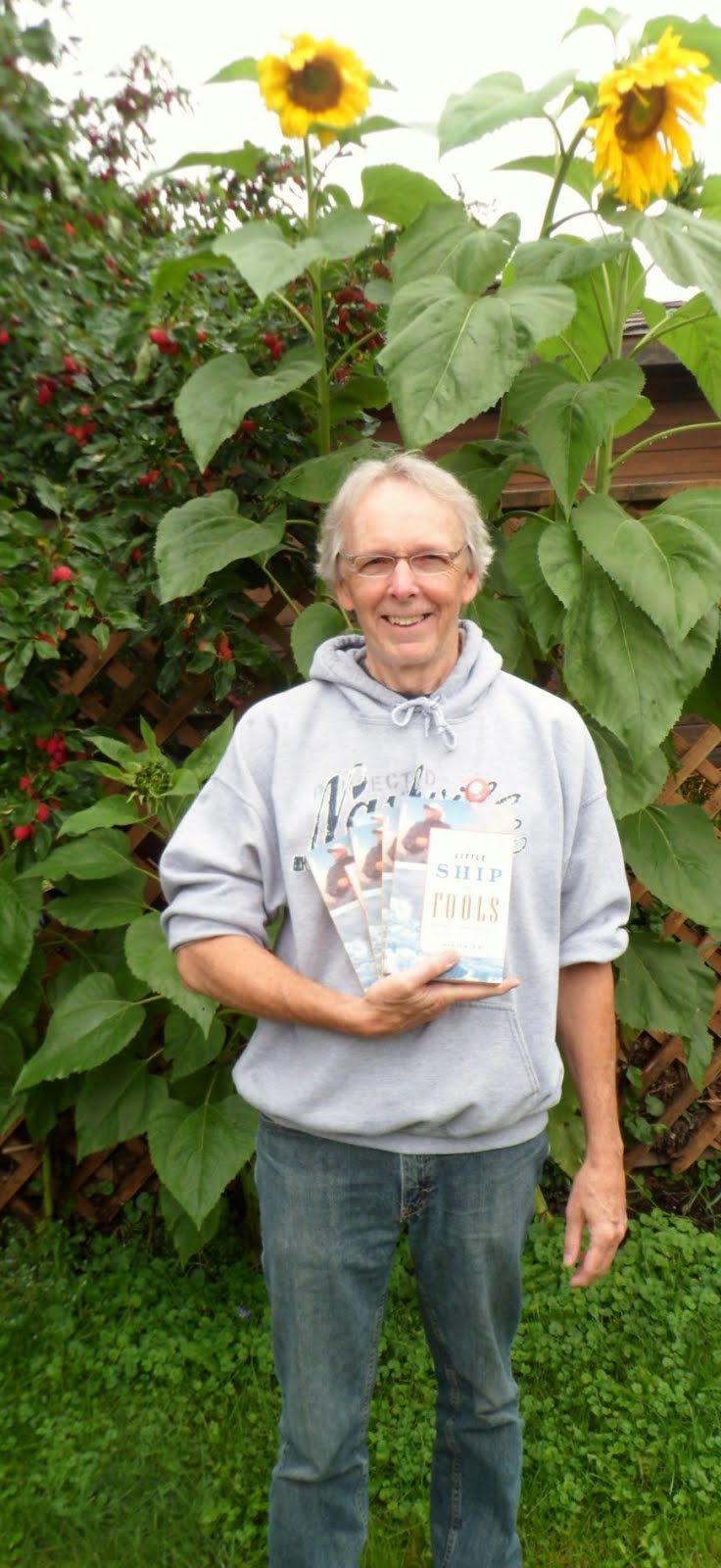





























































































































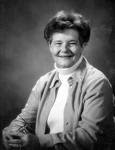


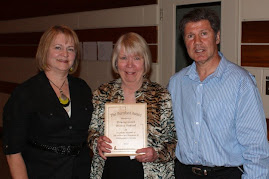









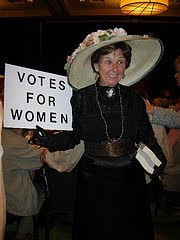




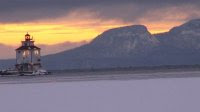
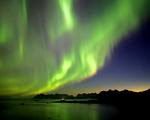










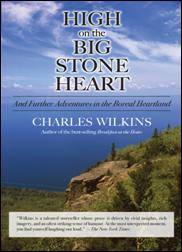



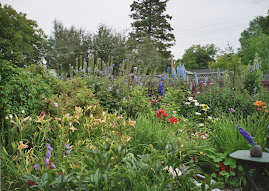

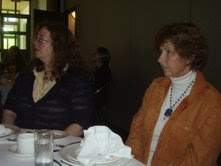











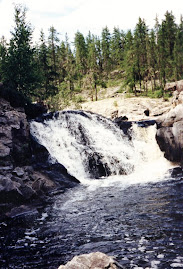







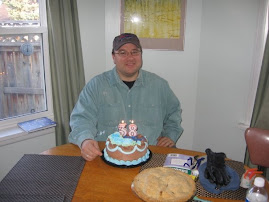

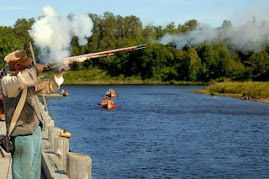
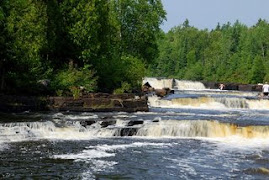

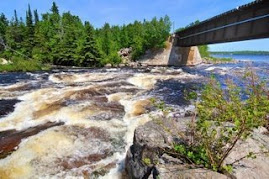
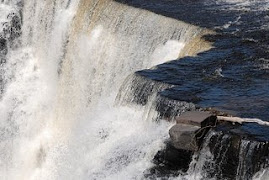





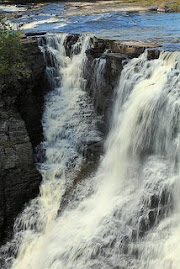

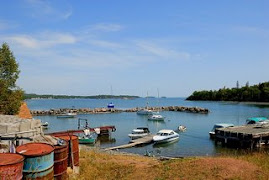

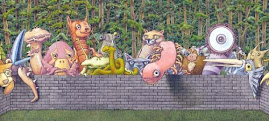
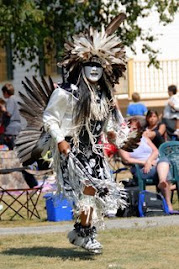
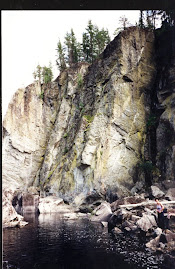
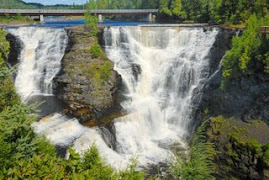
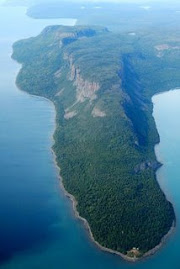
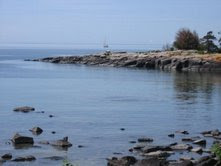

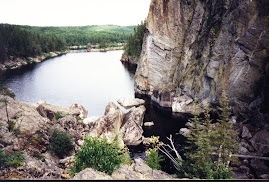
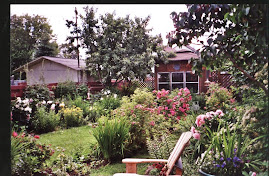
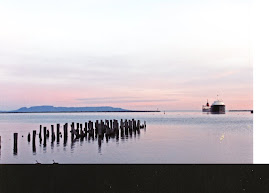







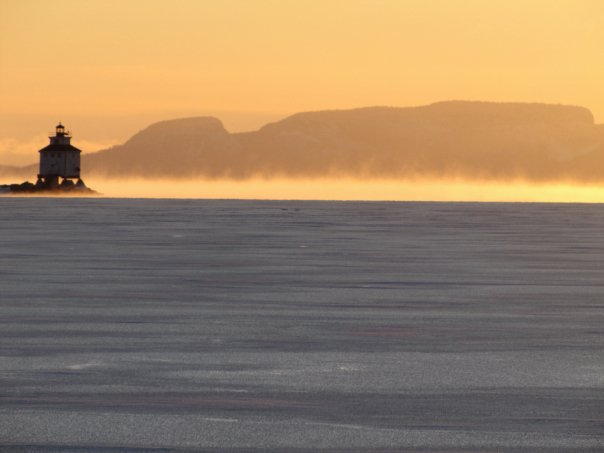

No comments:
Post a Comment